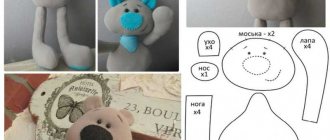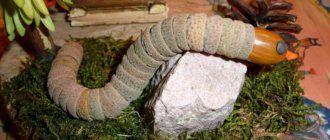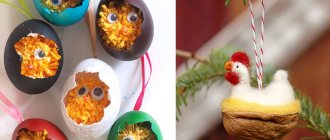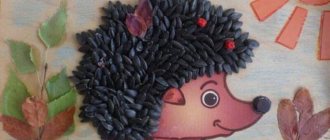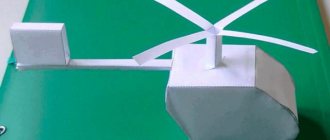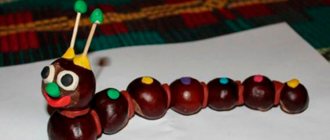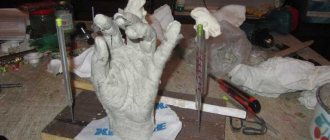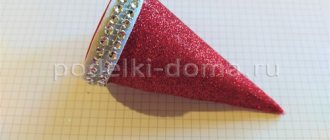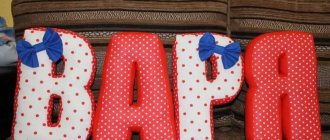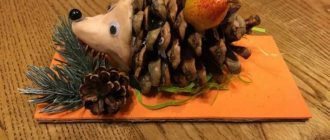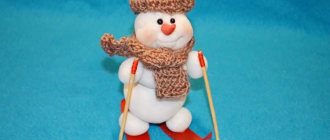Making a model of the Earth from various craft materials is a very exciting activity for creative people. Not everyone can afford to buy a ready-made globe, so let me offer you several options for making a model of the globe - using paper and using plasticine.
Be sure to involve your child in the process, he will probably be very interested in helping you, and he will also learn a lot of new things about our planet, easily remember what it looks like and what it consists of.
Globe formation process
The entire process of making a real globe consists of 3 stages. On each of them you need to perform the prescribed actions in a certain sequence. If you manage to avoid mistakes, then the likelihood of successfully completing the work you started will increase several times.
Creating a blank
It is best to use a balloon as the basis for the future globe. It is light weight and compact in size. It is better to use a ball that has a slightly flattened shape.
Procedure for making the base:
The round balloon is inflated and tied with strong thread. It is then placed on a jar, glass or any similar stand. The ball is lubricated with vegetable oil. Newspapers are torn into small pieces or cut into squares. They are dipped one by one in paste and glued to the balloon.
It is important to leave a small hole on the surface through which the ball can be removed. In this form, the workpiece is left to dry. This may take from 12 to 24 hours. After the specified time, cover the ball again with pieces of newspaper dipped in paste. After the composition has dried again, they begin to remove the frame.
To do this, pierce the balloon and carefully remove it from the workpiece.
Painting and application of continents
In order to turn the blank into a real globe, it is necessary to paint and apply images. First of all, you need to prepare the surface of the globe, and also print out stencils of the continents. These steps will greatly simplify your work and help you quickly achieve the desired result.
What can be made from empty cans: Wonderful ideas for your home
Sequencing:
- The entire surface of the workpiece is coated with a primer.
- After it dries, a layer of blue paint is applied, which will imitate the oceans.
- The product is left in this form for 12 hours.
- Using printed stencils, the contours of the continents are applied.
- Then they are painted over with acrylic paint. To create a realistic globe, you should use green, white, yellow and brown material.
- Having completed this work, leave the product to dry for 10 hours.
- The names of continents, oceans, islands and other large geographical objects are written with a marker or a simple pencil.
Making a stand
Any globe must have a stand. It can be done during periods when the painted product dries.
Plastic bottle caps: 10 creative ideas for using them
Stages of making a globe stand:
- The first step is to take a toilet paper roll and make vertical cuts on one side.
- The separated parts are bent and then lubricated with glue.
- The future stand is applied to the center of the plastic plate and held until the adhesive dries.
- The other side of the sleeve is also lubricated with glue and threaded into the hole that remains after removing the balloon. If it is too small, then you need to cut off the excess part of the base using a stationery knife.
- The product is left for 2 hours and then placed on a desk or bookshelf.
Making a globe yourself allows you not only to improve your skills in working with paper, but also at the same time to learn information about the continents and oceans. If you manage to perform all the steps correctly, the process of studying geography will become much simpler and more interesting.
Preparatory activities
Before you start making a globe at home, you need to find or buy all the required materials, as well as prepare a special adhesive composition. If you complete these preparatory steps in advance, you can significantly simplify the bulk of the work and reduce the time spent.
Gathering the necessary materials and tools
In order for the process of making a globe to bring pleasure and not create additional problems, you need to carefully prepare the workplace and collect all the items necessary for work.
The table on which a person will carry out all manipulations with the product is covered with unnecessary newspapers or oilcloth. Only after this, prepare the following materials and tools:
- small saucepan;
- glass container;
- plastic plate;
- tablespoon;
- scissors;
- brushes of different thicknesses;
- newspapers;
- primer;
- acrylic paint;
- balloon;
- pure water;
- Wheat flour.
Preparation of paste
During the work, you will need to glue various elements to the base. This can be done using a natural mixture - paste. To prepare it, take 1 cup of wheat flour and 5 times more water.
What can be made from empty cans: Wonderful ideas for your home
The adhesive composition is prepared in the following way:
- Pour 4 cups of cold water into a small saucepan.
- The container is placed on the stove.
- Over medium heat, bring the liquid to a boil.
- Pour flour into a separate container and mix it with the remaining water.
- The resulting mixture is added to boiling water in small portions.
- The paste is constantly stirred and cooked over low heat for about 2 minutes.
- Remove the finished mixture from the stove and cool to room temperature.
How to make a solar system with your own hands: master class with photos
What you need to prepare for the craft:
- corrugated cardboard
- scissors and stationery knife
- decorative tape
- PVA glue
- needles and carnations
Additionally, you will need paints. To make the planets look more realistic, print the template on a color printer.
STEP 1. Cut out 9 circles of different diameters from cardboard and color each of them. Use rich colors that are associated with space - black, dark blue, purple.
STEP 2. Once the paint has dried, place the circles on top of each other and staple in the center. We used part of a sushi stick; A toothpick or any other rod is also suitable for this.
STEP 3. Cut out stars from decorative tape or colored paper and stick them on the base. Experiment with sizes and shapes!
STEP 4. Cut out the printed images of the planets and glue them onto cardboard circles of the appropriate size.
STEP 5. Secure them to the base using nails. The hat is stuck into the base of the circle, and the planet is placed on the needle. Glue the rings of Saturn onto thin cardboard and connect them to their owner with needles.
You can add more variety and interesting moments to your children’s daily routine if you learn a new activity. To do this, you just need to captivate the baby. One of the educational and very original activities is making crafts with your own hands.
Video: How to make a globe from a plastic bottle
You know
do you know how to make a globe with your own hands at home?! Having searched the Internet for a solution to this issue, I decided to post my own instructions for making a miniature model of our planet. For production I will use the bare minimum set of available tools.
So let's start... To make a small globe we need:
1. Ball - the ball should be the size you want to make the globe. Don’t take one that is too huge, as you still need to print a map on it. 2. Silicate glue - ordinary silicate glue that is still used by children in schools. 3. Newspaper - a simple newspaper, 1-2 pages is enough. 4. A piece of polyethylene - Polyethylene is needed, preferably not hard, polyethylene from under a loaf of bread is quite suitable for this role. 5. A printer with a computer for creating a map and printing. 6. Scissors. Below you can see the instructions in photographs.
We take the ball, wet it with water, and glue pieces of polyethylene onto it around the circumference. If the diameter of the ball is about 20 cm, the pieces of polyethylene should be no more than 2x2 cm. After the ball is covered with one layer of polyethylene, you can begin to glue the newspaper.
Pieces of newspaper measuring about 2x2 cm must be glued carefully with silicate (paper) glue to prevent wrinkles from forming. Having completely covered the surface of the ball with one layer of newspaper, you can proceed to the next layer. You have to decide for yourself how many layers of newspaper to glue, depending on how strong you need the globe. But at the same time, the minimum number of layers of newspaper should be at least 5 layers. When the work is completed, it will take about a day for our ball to harden and acquire some strength. Day two. We take our future globe to make a perfect ball, do not forget to sand the surfaces with sandpaper (zero grade). Then we cut it into two even parts in half and remove the ball. You can return the ball to the owner; we will no longer need it.
Let's give our hemispheres some additional strength by gluing stiffeners to them. Ordinary CDs or DVDs can be used to enhance the hemispheres. We glue them as shown in the figure. After the glue has dried a little, you need to glue the hemispheres, first noting for yourself where the bottom will be and where the top will be. There will be an equator on the seam of the ball, the axis will pass through the holes on the CD discs. Having printed the card on the printer, before cutting it into slices you need to cover it with a layer of adhesive tape. After this, carefully cut the unfolded globe into orange slices and glue it onto the ball. First we glue one half of the development, then we take on the other.
If everything is calculated correctly, you should end up with a globe like this.
Need to do scrupulous but interesting work
It is important to find the most suitable card possible and print it. There are many ready-made globe layouts on the Internet.
An old political map will also work.
When making a paper globe with your own hands, make sure that the scale of the map and the base on which the map is glued match. You can make the base in several ways.
Round box
You will need: intertwined cardboard, a spray gun (spray with water), a simple pencil, a ruler, a centimeter, whatman paper, burlap, twine, glue moment Crystal, glue pencil for fabric, padding polyester, cotton, compass, cutting mat, clamps, elastic band , oilcloth, scissors, stationery knife, thread and needle, leatherette pen or other decorative elements.
Master Class
- Cut out a rectangle measuring 54x10cm from interwoven cardboard.
- Moisten it with spray spray on both sides, twist the circle, secure with a clamp and leave to dry.
- Glue the junction of the circle with a strip of thin paper.
- Measure the inner diameter of the bottom, we got 16.7 cm.
- Draw the bottom on the woven cardboard using a compass.
- Cut out connecting strips from whatman paper using denticles with a total length of 54 cm and a width of 2 cm.
- Glue the bottom to the main part using connecting teeth.
- Prepare a rectangle of burlap measuring 56x15cm, then sew its edges.
- Place the burlap blank over the main part of the box.
- Glue the burlap along the edge of the bottom, then along the top edge of the main part of the box.
- Cut out a rectangle of woven cardboard 57x3cm. Moisten and secure with a clamp - this will be the lid of the box. Set the piece aside to dry.
- Measure the diameter of the bottom, ours is 16.5 cm. Using these dimensions, draw a circle on whatman paper with a compass, cut it out and glue it to the bottom of the box.
- Measure the inner diameter of the box.
- Prepare a rectangle with denticles from whatman paper measuring 53x9.5 cm.
- Prepare a cotton rectangle measuring 53x11cm and glue it onto the rectangle of whatman paper with special glue for fabric, leaving the teeth free.
- Prepare a rectangle of oilcloth measuring 57x6cm and sew lace trim along the edge.
- Sew a transparent blank to the fabric with whatman paper and make 4 pockets.
- Glue a blank with pockets around the circumference of the box inside.
- Secure the edge using clamps.
- Cut circles from whatman paper and padding polyester with a diameter of 16.3 cm, and from cotton with a diameter of 17.3 cm.
- Glue a circle of padding paper and cotton together, then glue it to the bottom of the box.
- Make the lid of the box in the same way as the base. We made the blank in step 11. The diameter of the lid is 17.7 cm.
- Cover the lid with burlap and twine.
- Attach a leatherette handle to the top of the lid or decorate the box to your taste.
The round box is ready! I recommend watching this video!
DIY jewelry box Dressing table decor element 2019
Watch this video on YouTube
Globe mockup made from cardboard blanks
For such a globe, you need to patiently and correctly make several pentagonal cardboard blanks. This is the most difficult and responsible part of the work. Their number will depend on the size of each of them. You need to complete the elements according to the diagram.
What to do next, how to make a globe with your own hands from these strange elements? Cut the map into the same elements and glue it with PVA glue onto the cardboard parts of the future globe. You should have a construction kit that can be assembled from spare parts, and which can later be disassembled if you notice that some part has been glued incorrectly. Take your time. All elements must then be assembled in strict sequence so that the copy of the land is correct.
The task is not as difficult as it seems. But, naturally, the child will need the help of an adult to create this interesting model.
How is a map different from a globe?
You can immediately say that the difference between a map and a globe is that it is flat, while a globe is round. It is due to this factor that there are many differences between the terrain that is plotted on the map and the one that is indicated on the globe. Here are some of them:
- the globe is more visual, it shows the surface of the planet more realistically;
- the map can be on either a small or large scale;
- The proportions of objects on maps are more distorted.
As we know from history, for some time people were sure that the Earth was flat. But not everyone thought so; many ancient scientists knew that our planet was spherical. It was thanks to this knowledge that the first globe appeared a century and a half before the beginning of our era. Maps appeared much earlier, but not as a teaching aid; they were used as a guide in travel.
DIY globe: 5 step-by-step master classes with photos
The globe is a model of our beautiful planet. This ball can be a stylish decorative element and an educational gift. In this article we will look at: how to make a globe with your own hands.
Huge globe made using papier-mâché technique
You will need: a fitness ball, PVA construction glue, film, rope, paper, newspapers, scissors, pencil, brushes and paints.
Master Class
- Wrap the fitness ball in film and tie a loop for further hanging.
- Wrap the ball with rope.
- Hang the ball to make it easier to work with.
- Cut the newspaper into pieces, dip the paper in water, then attach it to the ball.
- Cover the ball with pieces of newspaper in several layers.
- Cover the ball with pieces of white sheets in several layers and wait until dry.
- Draw the outlines of the continents and oceans with a pencil.
- Paint the globe with paints and wait until it dries.
- Deflate the ball through the top hole and remove it along with the film.
- Cover the hole and outline it.
A huge globe made using papier-mâché technique is ready!
Beaded globe box
You will need: a wooden blank - an opening ball with a stand, a simple pencil, beads - blue, light pink and gold, thick wire, thin fishing line, instant glue, acrylic varnish, glitter, scissors, a screwdriver with a thin drill, a hammer, acrylic paints and a brush.
Master Class
- Draw the outlines of the continents on the ball.
- Weave a belt into 2 beads: one row is gold - this is the equator, and the second row is colored. During weaving, you should constantly apply the fishing line to the ball and orient yourself along the intended lines, that is, blue beads are water, and pink beads are land.
- Sew the belt into a ring, apply glue to the edge of the box (the middle of the ball) and put on the beaded belt, then wait 15 minutes for the belt to stick well.
- Weave the next row in the same way: string blue beads in place of water, and pink beads in place of sushi, do not forget to constantly apply to the ball and try on the continental lines. Only after careful fitting should you glue the fishing line with beads to the ball. It is worth noting that it is necessary to give each row time to dry so that the rows do not move and the work does not deteriorate.
- Braid the entire northern hemisphere, then the southern.
- Braid the stand with golden beads, just leave a small gap unbraided for the future hole.
- Prepare a piece of thick but flexible semi-circular wire and tap the end with a hammer to flatten it.
- Drill a hole in the base and glue the flattened end in, then leave to dry.
- Paint the inside of the box pink and wait until dry.
- Mix acrylic varnish with glitter, cover the globe and leave to dry.
- Weave a square rope of golden beads the length of the wire tail, cover the wire with it, and cut off the excess end of the wire.
- Glue the golden bead so that the end of the wire is not visible.
The globe-shaped box is ready! I recommend watching this video!
Children's globe
You will need: a balloon, blue paint, a brush, newspapers, a glue stick, felt-tip pens.
Master Class
- Inflate the balloon.
- Cover the ball with pieces of newspaper in several layers.
- Paint with blue paint and wait until dry.
- Print out the continents, color them with markers, then cut them out.
- Glue the continents onto the ball.
The children's globe is ready!
Globe made of buttons
You will need: a foam ball and cube, blue and green buttons, acrylic paints, brushes, toothpicks, glue, aluminum plate.
Master Class
- Place the ball on the cube using toothpicks.
- Draw the continents on the ball.
- Paint the continents green and the water part blue.
- Apply glue to one continent and glue the green buttons. Thus, cover all the continents with green buttons, and cover the water part with blue buttons.
- Leave the structure to dry.
- Paint the cube with brown paint and wait until it dries.
- Remove the toothpicks and place the aluminum plate on the cube and place the button globe on top.
The button globe is ready!
Globe in vintage style
You will need: an old globe, white paint, a simple pencil, a charcoal pencil, a brush, an eraser, ink sponges of any color, spray sealant.
Master Class
- Separate the globe from the base.
- Paint the globe with white paint and leave to dry.
- Trace the outlines of the continents with a simple pencil.
- Trace the outlines of the continents with a charcoal pencil to make them more expressive.
- Blend the lines along the outline using an eraser.
- Coat the globe with a sealant spray.
- Dip your fingers into the ink sponges and mark your dream spot on the globe.
The vintage style globe is ready! I recommend watching this video!
Globe bar. Interior accessory for dolls. MK
The top contains bottles of alcohol! And a drinking doll)))) Sounds very nice, let it be)))) There are a lot of books and photos in the topic! So, hello everyone! Just the other day I read one very interesting topic from the wonderful master of dollhouse miniatures Natasha Makarevich Miniaturefood. Her works include a lot of dishes and very realistic bottles with all kinds of alcohol. I found Natasha both on VK and on YAM, I saw enough of these wonderful works to such an extent that I unbearably wanted to make one thing out of my dreams, a globe bar.
Natasha's Fair of Masters Natasha's page on Vka In ancient times, I worked as a bartender and really love beautiful bottles and dishes, but I have nowhere to put such an item in my apartment, and there is no need... I am an absolutely non-drinking person, for a long time...
And it’s quite a puppet! So the work on correcting the mistakes began... First, I ordered a wooden ball from YAM, a blank for boxes, 12 cm in diameter. There are laser cuttings from plywood in the bins, as well as legs for boxes. A sheet of cardboard for drawing, it is so thick and primed on one side, I really like making crafts with it. It cuts perfectly with a breadboard knife, and when gluing two or more layers, it becomes suitable for sanding, but is much lighter and simpler than plywood. Also Moment-Stolyar glue and yacht varnish.
I wanted to make a globe in Decoupage style and I ordered napkins with different cards. A large globe will be for 1/4 dolls. I ordered dishes and bottles from Natasha. While I was waiting for my order, I decided to make a small globe for 1/6 dolls. I bought 2 bottles of champagne and 4 glasses from Natasha. The globe itself is made of papier-mâché. Covered with napkins (I had some at home) Painted with acrylic and varnished. The legs and the circle at the bottom are made from cutting. The parts are glued together 2 at a time, sanded and painted. I assembled everything using glue and nails. The insides are made of cardboard, the arc of the handle too. The handle is a turquoise bead. This is the globe itself, small.
This is with bottles and a drinking doll)))) I'm dying from this phrase!)))
Natasha made 1/6 bottles and glasses and they go perfectly with the Fizen doll. The glass fits perfectly in your hand! In general, Natasha has several different shapes of glasses, but I chose these. They even have champagne bubbles! Lovely)))
It was the turn of the big globe. The napkins turned out to be hopelessly small and I had to make a map of the unknown world on the globe)))) Don’t look for the usual continents there, they are very far from our world!)))) First, I collected everything on clean blanks. The legs are glued 2 pieces together. Moment-carpenter magic glue! The main thing is to press them well and fix them for a while. Stone! I fastened it with ordinary sewing pins, then small finishing nails will go into these holes. I drilled with a tiny hand drill. After assembly, I disassembled everything again, marked the parts and joints with numbers, directly on the blanks, with a simple pencil. After that I started decorating. The interior decor is based on the painting “The Birth of Venus” by Botticelli. Decoupage card on rice paper. I cut it out, tried it on, cut it out, tried it on, then glued it on. After the glue had completely dried, I covered it with two layers of yacht varnish. Moment-joiner glue dries very quickly and you can’t move the picture if you apply it to this glue! The first layer of yacht varnish takes a long time to dry - 10 hours. The second coat is faster, but I let it dry thoroughly! This varnish creates a thick film of irreversible coating; it cannot be washed off, it can only be cut off or sanded off. I dilute it with a little white spirit. I like it thinner better. And another brush - only hard and round! At the base of the lower bowl there is also an image - a fragment of that painting, it is pasted onto a circle and glued in the very center of the lower bowl. The walls are painted gold. below, on the base circle, Venus herself.
Then I cut out blanks from cardboard for shelves for glasses and a tabletop with slots in a circle, where glasses and bottles are inserted. The bottles will stand in the middle, there is a deep place. Along the perimeter, just above the bottom, there is a shelf for placing wine glasses, like here
I cut out a “ring of Saturn” to the upper edge of the lower bowl; it fit into the recess in the lower part of the workpiece. Everything was painted, varnished and assembled with nails. I didn’t use any glue; everything stuck to the varnish layer of the other piece by itself. There is a small loop between the two hemispheres. The arc of the handle is made of cardboard, the handle itself is a bead of an elongated pearl strung with glue and a nail, a round bead, an arc of the handle and again a bead. Painted with acrylic and varnished. While there is nothing to fill, I found 2 bottles - lighters... The filling from Natasha will arrive soon, then we’ll start a photo shoot with a doll and alcohol! We'll walk until the morning!))))
Ufff, fsyo))) Thanks to everyone who was able to make it to the end! Ask questions, I love everyone, good luck to everyone!!!
Unicorn
You will need: a sleeve, colored paper, scissors, glue, glitter and colored cardboard, rainbow colored yarn, black marker, pink lipstick or pink pencil.
Master Class
- Cover the sleeve with colored paper.
- Wrap different colors of yarn around 3-4 fingers, then cut and shape into a mane and tail.
- Glue the mane and tail to the sleeve.
- Cut a triangle out of glitter cardstock and glue it on as a horn.
- Make ears from triangles of different colors and sizes, as shown in the photo.
- Glue the ears next to the horn.
- Draw eyes and eyelashes with a black marker.
- Draw on the cheeks with pink fondant.
The unicorn from the sleeve is ready!
Globe for the little ones
Try making a globe for your little child with your own hands from plastic plates. It's very simple and won't take much time. Just cover 2 plates with patterns and glue them together.
But if you don’t find such a layout, then download the usual one, which only shows the meridians. And then glue the cut out continents on top. On the continents, your child will draw whatever he wants. This is a “trial version” to show your baby what the planet looks like. You can even not glue the meridian layout, but simply stick on blue paper depicting the oceans. You can also recommend that your child make continents from plasticine and use superglue to attach them to the plates in the places you indicate.
All the given copies of the Earth are made in order to interest the child and spend time with him. But such a globe, made with your own hands, will not be educational material. These crafts are low-precision models. But at the same time, making an entire globe with your own hands - who wouldn’t be interested?
Perhaps such an original paper globe can be useful not only for schoolchildren to teach them geography, but also for decorating the interior with unusual paper crafts. And the main thing is that you can make it with your own hands from paper by simply downloading the globe diagram.
And such an interesting craft - a paper globe - was developed by French designer Joachim Robert and posted for public use. Now anyone can download the diagram of this globe, print it on paper, cut it out and assemble it according to the diagram. We will show you how to make such a globe out of paper in today’s post.
Cooking the paste
Before you make a globe from paper with your own hands, you need to prepare a binding solution - a paste. Pour four glasses of water into a saucepan and bring to a boil. Meanwhile, in another container, mix the flour with the remaining liquid. As soon as the water boils, gradually add the resulting mixture into it, stirring constantly.
Reduce heat to low and cook for a couple more minutes. Don't stop stirring otherwise it will burn. The finished paste can be placed in a cool place so that it cools faster.
How to make a globe with your own hands from papier-mâché
Preparation of material
To make this craft you will need:
- round balloon;
- newspaper or scrap paper;
- pot;
- water - 1200 ml;
- flour - 200 g;
- water-based paint;
- gouache - 6−8 colors;
- scissors;
- brushes for glue and painting;
- furniture varnish.
The method of making crafts using papier-mâché involves covering a base with several layers of paper and then painting it. The frame for the future globe will be a round-shaped balloon. Its diameter can be any - at your discretion. Such a balloon needs to be inflated, tied tightly and checked to ensure that it does not allow air to pass through. Then place it on a wide and stable glass or small vase - they will be useful as a stand for subsequent work.
Now you need to prepare the glue. To do this, you can use ordinary PVA, which is diluted with a small amount of water to make it less thick, since the drying speed of the craft depends on this .
Usually,
add one part of water
to two parts of medium-thick and mix well.
You can also weld the glue yourself. To prepare it, you need to take a small saucepan, pour 1 liter of water into it and boil. Mix the remaining liquid with flour, make sure it is well dissolved, and then pour a thin stream into boiling water. Stirring constantly, boil the solution for 3-4 minutes over low heat. After this, remove the finished glue from the stove and place it in a cool place until it cools completely.
Stages of work
Now you can start making a model of the Earth:
- Take a balloon and grease it with vegetable oil. This must be done so that later it can be more easily removed from the finished template. Then take the newspaper and tear it into small pieces. It is worth keeping in mind that you do not need to cut the paper, as this will show clear lines on your ball, and this will look unsightly. Pieces with torn edges fit better on a round shape and therefore the surface of the globe will be smoother.
- Now dip paper strips into glue and stick them onto the ball. It is recommended to make 2-3 layers, then the model will be stronger. Be sure to leave a small hole near the base so that the popped balloon can be pulled out through it.
- Place the pasted ball on the stand, place it in a warm place and let it dry thoroughly for 24 hours. If the glue was very thick, or you applied too many layers of paper, then the drying time may increase to 2 or 3 days.
- When the papier-mâché craft becomes dry and strong, pierce the ball with a needle, release the air and pull it out of the paper base.
- Then the workpiece must be coated with water-based paint; 1-2 layers will be enough. Leave until completely dry.
- After this, you can start painting the layout. To do this, take gouache and paint the ball blue. Then, using a simple pencil, draw continents, islands and countries. If you find it difficult to cope with this, you can use special templates. Carefully color everything with the appropriate colors. Using a felt-tip pen, sign the names of countries, continents, seas and oceans.
- After processing with paints, you can cover your model of the Earth with one layer of transparent furniture varnish, then your globe will not stain your hands, and if water accidentally gets on its surface, it will not spoil the drawing.
Model of the Earth made of multi-colored plasticine
Features of the craft and material used
This model will demonstrate the inner and outer surface of the Earth: core, mantle, crust and oceans with continents . To do this you will need quite a large amount of plasticine of different colors. Before starting work, it is recommended to study in detail the structure of the globe so that all its components are located correctly in your model.
For this craft you will need:
- a lot of multi-colored plasticine;
- stack;
- knife;
- wooden plank;
- ball pen;
- pictures depicting the inner and outer surface of the Earth.
Making a layout
After preparing the material, you can start creating your model of the Earth:
- First you need to create a kernel. To do this, take yellow plasticine and form a ball out of it. It can be any size, but it is best that its diameter is 7-8 cm.
- Now let's sculpt the outer core of the Earth. Take equal-sized pieces of red, orange, yellow plasticine, soften them and mix them together. Roll out the resulting mass into a layer about 2 cm thick and wrap it around the yellow kernel so that it completely covers it.
- We make a mantle. To get the color that suits it, mix yellow and brown plasticine. Then roll it out so that its thickness is 3-4 cm, since the mantle is wider than the outer core. Wrap the existing ball into the resulting piece and smooth out all the irregularities well.
- Let's start making the earth's crust. Take brown plasticine, and if you don’t have that color, then to get it, mix equal pieces of red, black and yellow plasticine into one common mass. Then form a thin layer - it will be the earth’s crust in your model. Then carefully wrap it around your globe model.
- Now we have to start decorating the outer layer of the globe. To create water, take blue plasticine, roll out a layer 1 cm thick and wrap your craft in it.
- Then you need to recreate continents, islands and glaciers on the surface of the Earth model. To avoid mistakes, you can mark their location with a ballpoint pen and then begin to shape the surface of the land. Glue the corresponding colors in small pieces, carefully spreading them over the surface. To make the continental land look natural, first stick on a little green plasticine, and then add brown, yellow, beige and connect all the colors with smooth transitions.
The finished globe needs to be cut into two parts to demonstrate what layers the planet Earth is made of. This can be done with a sharp knife or ordinary strong thread. You need to cut exactly in the middle to capture the inner core of the layout. You can also cut out a triangle deepened towards the center from the side of the model - in this section the structure of the inner surface of our planet will also be clearly visible.
The basis for models of the Earth , Moon or other planets can also be ready-made balls, plastic balls or oranges. To do this, on a round surface, you first need to mark the areas of land and water with a felt-tip pen or pencil, and then use multi-colored plasticine to fill them with the corresponding color.
On a stick
For another option for making a globe, see the next master class.
To make such a model of the Earth you will need:
- Plastic or foam ball;
- Thick wooden skewer;
- A glass of sour cream;
- Plasticine;
- Colored paper;
- Buckwheat and semolina;
- A real globe.
You need to make a hole at the base of the ball and connect it to a wooden skewer using plasticine. The lower part of the skewer needs to be strengthened in the cup also with plasticine. The side walls of the cup can be covered with colored paper or painted with acrylic paint. Apply blue plasticine to the ball in an even layer. Coat a wooden stick and the bottom of the glass with white plasticine. Based on a real model of the Earth, make continents from rolled out green plasticine. To do this, you can use their patterns. Using yellow and brown plasticine, mark the hills and mountains. Sprinkle the places where the glaciers are located with semolina, and the places where the highest mountains are located, encrust with grains of buckwheat. The globe on a stick is ready!
Making a homemade globe that is exactly like a real model of the globe requires scrupulous but interesting work.
It is important to find the most suitable card possible and print it. There are many ready-made globe layouts on the Internet.
An old political map will also work.
When making a paper globe with your own hands, make sure that the scale of the map and the base on which the map is glued match. You can make the base in several ways.
Citrus option
Try making a model of the globe from plasticine with your child. Why plasticine? This material is ideal for children's crafts. It is very flexible, convenient and safe to work with. Modeling classes help train fine motor skills of the hands, which contributes to the development of speech, because the speech center and the center responsible for coordinating the fingers are located nearby in the brain. Thanks to modeling, attention and memory are trained, and making crafts that are close to real models helps to better understand the essence of things. And of course, the child’s imagination develops and the child’s creative potential is realized.
Article on the topic: Crochet an openwork heart. Scheme
The master class with photos below will help you create a globe with your own hands.
So, to make a three-dimensional model of the globe, you will need:
- Grapefruit or large orange;
- Ball pen;
- Plasticine of various colors;
- Stack;
- A real globe.
Prepare the base by thoroughly washing and drying the fruit. Using a ballpoint pen, draw the outlines of the continents onto the orange. This can be done by attaching tracing paper to a real globe and redrawing the outline of the land onto it. Then cut out the pattern and trace it on the orange with a pen. Or you can draw continents from the globe by eye.
Most of the globe is occupied by oceans. This is where you need to start making the model. Next, mark the continents in green.
Don't forget that Antarctica and Greenland are covered with snow, they will be white.
Now you can apply the hills. Looking at the actual map, apply yellow clay where needed.
The next color to apply is orange. Don't forget to check the map.
Mark the highest places on the globe in brown.
Add deep areas in the ocean with dark blue clay.
Look how bright and beautiful the globe turned out.
Main parts of the master class
- 1 part. Introduction. At the beginning of the master class, be sure to show the finished product and the result you will achieve in the end. Assess the complexity of MK, give brief recommendations before starting.
- Part 2. Tools and materials. It is better to give them in a bulleted list in the text. If necessary, you can add several sentences for each item to the list. If there are materials that require additional detailed description and some recommendations, then it is better to put this in a separate paragraph after the list.
- Part 3 – step-by-step description.
- Part 4 – tips and tricks.
- Part 5 – contacts. The last point is to indicate your coordinates where you can be contacted.
